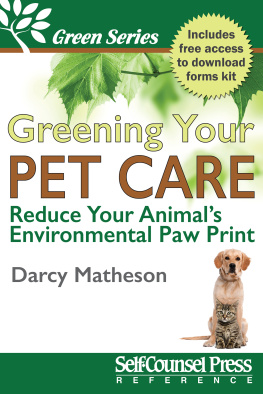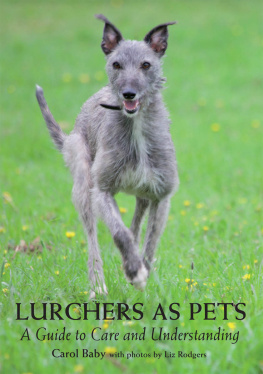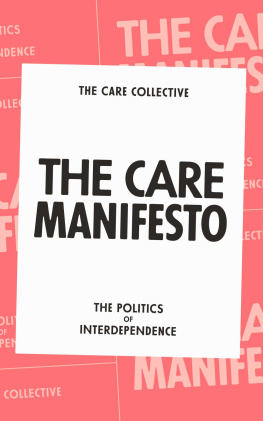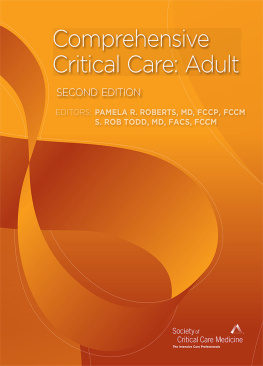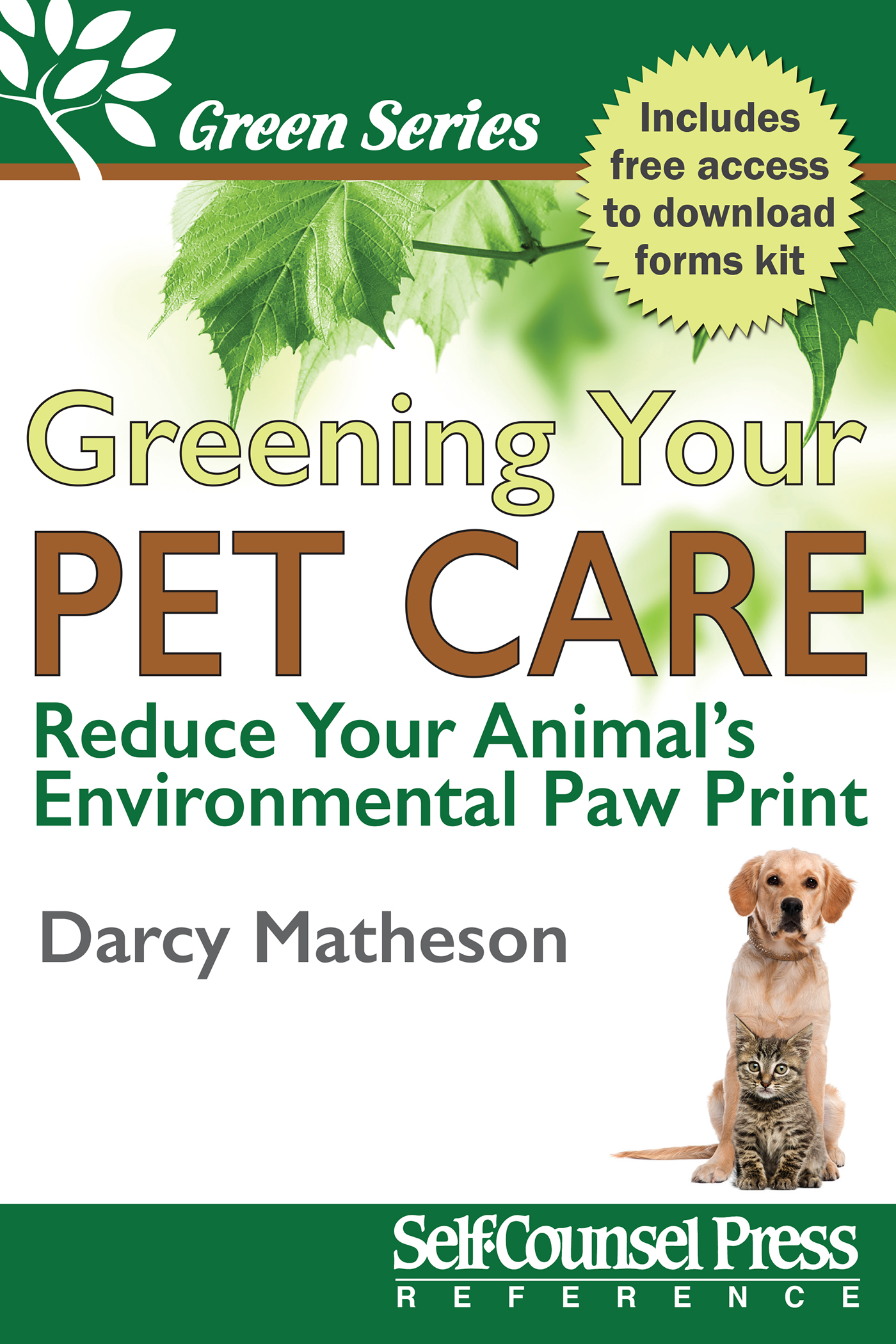Introduction
Our population and our use of the finite resources of planet Earth are growing exponentially, along with our technical ability to change the environment for good or ill.
Stephen Hawking
Theyre small, theyre adorable, but few of us realize the enormous impact our companion animals have on the environment.
In their 2009 guide to sustainable living, authors Brenda and Robert Vale found that a medium-sized dog has a carbon footprint of 2.1 acres, roughly twice the 1 acre for a gas-guzzling sports utility vehicle driven 10,000 kilometers (6,214 miles) a year. Its not just dogs that are contributing to pollution. The couple found that cats occupy the same footprint as a small Volkswagen, while two hamsters equal the same emissions as a plasma-screen television.
By their very nature, many family pets are carnivores, and its that meat-eating diet that contributes to their substantial carbon footprint. Producing the grain and meat for pet food consumes a vast amount of resources specifically land, energy, and water. That meat production belches harmful greenhouse gas emissions into the atmosphere in staggering amounts. The Food and Agriculture Organization of the United Nations estimates livestock production is responsible for 18 percent of all CO2 emissions worldwide.
Putting that into perspective, my 15-pound terriers each eat one cup of meat-based kibble every day. Thats 730 pounds of pet food required for two small dogs in only one year. Using the American Society for the Prevention of Cruelty to Animals (ASPCA) pet population statistics that means 29.2-billion pounds of food is produced for dogs in America in a single year. Consider that the average dog lives for 12 years.
Beyond their meaty diets, there are other factors bumping up that carbon paw print. Animal waste and the plastic bags used to throw it away contribute to millions of tonnes of waste in municipal landfills each year, and pollute rivers and streams used for human drinking water. In my hometown alone, an estimated 97,000 tonnes of dog waste is disposed of in Metro Vancouver regional parks each year.
Theres also all the bedding, clothes, toys, and supplies we lavish on our pets. Spending for pet products reached an all-time high of $60.5-billion in the US in 2015. Were shelling out big bucks for many products that are plastic, bad for the planet, and not necessary to enhance and enrich the life and well-being of our pets.
The carbon footprint of our family pets is poised to grow exponentially in coming years. The number of household pets has more than doubled in the US since the 1970s, says the Humane Society, and tens of millions of North Americans now share their homes and lives with animals.
Its estimated there are up to 86 million dogs and 103 million cats owned in North America, and millions of rabbits, reptiles, snakes, turtles, hamsters, guinea pigs, and other small animals. More than 105-million fresh and saltwater fish are kept in home aquariums.
Unlike previous generations where dogs were relegated to the backyard, its now much more likely to see the family Fido in its masters bed than in a wooden doghouse. The vast majority of pet owners surveyed in 2014 (86 percent of dog owners and 89 percent of cat owners) said they considered their pets to be a part of their family.
There are good reasons they are called companion animals. Pets provide friendship, lower our stress levels, act as emotional support, and have huge positive effects on our mental well-being, fitness, and happiness. So while we as human beings strive to make positive eco-friendly choices in our daily lives to reduce our own carbon footprint, it makes perfect sense that we extend those efforts to our familys smallest members.
This book will give you tips and strategies to become an eco-conscious pet owner, from the food and treats you buy to veterinarian care and the products you use in your home and garden. Each chapter provides simple everyday hints and actions that will lower your pets carbon footprint for the sake of their health and well-being and the future of our planet.
Chapter 1
Ten Simple Steps to Going Green
No matter if your household pet is a four-ounce gerbil or a 140-pound Great Dane, there are simple things we can do make the lives of our companion animals less wasteful and harmful to our environment.
This chapter includes ten simple everyday steps you can take to make your pet ownership more eco-friendly.
1. Step 1: Avoid Beef
Compared to any other animal, the production of beef has the most harmful effects on our planet. In a 2012 United Nations report on how meat production contributes to greenhouse gas emissions, factory-farm livestock production was identified as one of the top three most significant contributors to the worlds current environmental problems, and a significant contributor to climate change. Because of their feeding requirements, methane production, and large body size, beef has a much larger carbon footprint than other forms of protein such as pork, chicken, turkey, sheep, goat, lamb, and rabbit, and exponentially more than grains and vegetables.
Because some household pets, such as cats, are obligate or true carnivores that require meat for their nutritional requirements, its not appropriate to remove meat from their diets. However, the consumer marketplace is filled with choices and alternatives so its easy to find substitutes for beef as a primary protein in their daily meals.
Making slight changes in your pets diet will go a long way to reduce how much they contribute to greenhouse gas emissions. Instead of choosing beef-based kibble or wet food, switch to a food in which a primary protein is something with a smaller footprint, such as chicken or sustainably harvested fish. Just make sure to incorporate changes into your pets diet slowly, to avoid stomach upset.
You can take it one step further by supplementing meals with foods that have a significantly smaller environmental footprint, such as pet-friendly non-animal proteins (e.g., legumes, cereals, grains, fruits, and vegetables). The same goes for treats: Look for grain, cereal, or fish-based treats instead of those sourced with beef.
With more than one-third of all spending on pets falling into the food category an estimated $23-billion for 2015 alone, according to the American Pet Products Association your individual choice can add up to a big difference. If more pet owners turn their back on beef-based pet food, less manufacturers will produce it because there will be less demand.
If you are ethically opposed to feeding your pet meat, there are quite a few options. Chapter 5 (dog care) discusses the matter of canines going vegetarian, and vegan food options. You can also opt for pets that dont require meat in their diet at all. Rabbits, for instance, are herbivores and not only are they vegetarian, but theyll happily gobble up any veggie trimmings and leftovers you have, making them very eco-friendly companions.
2. Step 2: Reduce Your Transportation Footprint
Vehicle travel is one of the worst carbon emitters in most peoples lives, but few of us think about how transportation pollution factors into the pet world.

